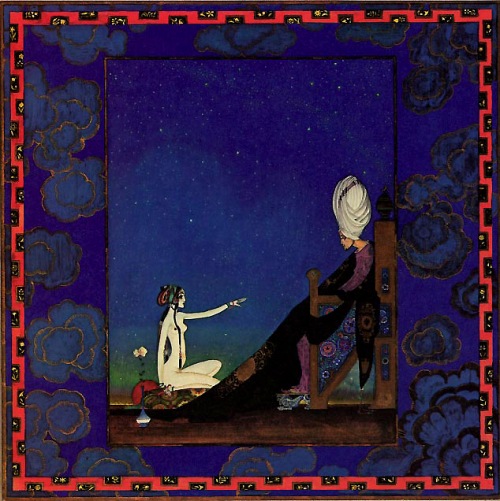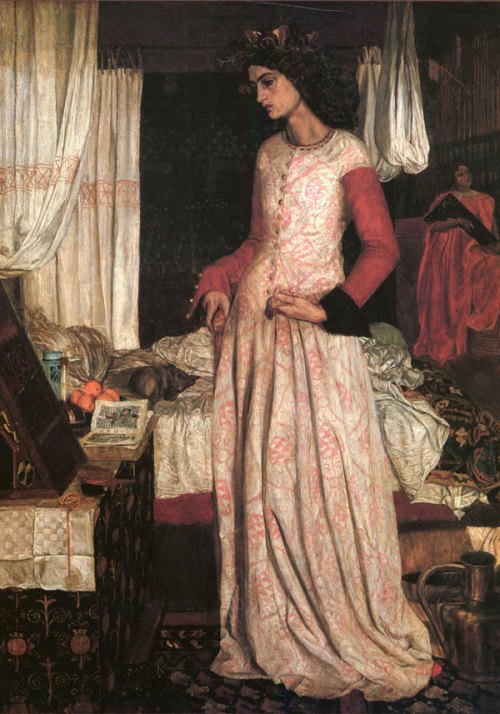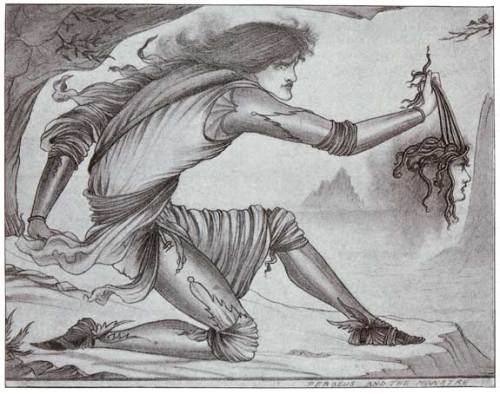
The Sultan and Scheherazade, Arabian Nights - Kay Nielsen
Of Fairy Tales and Folklore
We should not be surprised that the transliterator of Cinderella and Snow White, and the transliterator of Aladin and Ali Baba, were friends. Working for the same boss in separate cultural offices, Charles Perrault and Antoine Galland carved out different facets of a literary niche that has endured across centuries, not unlike the stories they retold. Both profoundly influenced later authors.
In 1695, at the age of 67, Charles Perrault lost his job as Secretary to the Academy of Inscriptions and Belles-Lettres. With plenty of time on his hands, he embarked on a project to bring the stories he had heard since childhood into printed form, and published his Tales and Stories of the Past with Morals in the same year.

Arabian Nights : Fisherman and the Genie, Maxfield Parrish
When Scheherazade Met Sinbad
The Academy of Inscriptions and Belles-Lettres where Perrault had worked was under the administrative control of Loius XIV’s finance minster, Jean Baptise Colbert. During that period, another of Colbert’s employees, Antoine Galland, was occupied with preparations for a compendium of Middle Eastern Literature, the Bibliothèque Oriental. In this library was a manuscript of a cycle of stories that Galland translated and published with the name The Tale of Sinbad the Sailor. Partly due to the popularity of his friend’s work on fairy tales, Sinbad became immediately popular as well. Perrault himself then encouraged him to complete a more ambitious project, a translation of a manuscript that Galland had collected in Instanbul called “Alf Laylah wa Laylah” or The Thousand and One Nights.
Curiously, of all the most popular stories in that collection, only the framing tale of Scheherazade was part of that manuscript. The Sinbad tales came from a separate source, but those stories that came to be called in English “Aladdin, or the Wonderful Lamp” and “Ali Baba and the Forty Thieves” were drawn directly from oral tradition: A Maronite Christian from Allepo in Syria visited Galland in Paris and narrated those stories to him from memory.

Aladdin and the Genie of the Ring - Virginia Frances Sterrett
The Arabian Nights in England
Of the two contemporary authors, Gallard had traveled more extensively than Perrault, though less so than another well-traveled translator of the Thousand and One Nights, Sir Richard Francis Burton. Burton’s biography is a tale on its own; Burton began his travels as an officer in the army of the British East India Company, spending time in Afghanistan and India and becoming familiar with the local cultures. He then took leave to work for the Royal Geographic Society, disguising himself as an Arab and going on a pilgrimage to Mecca, one of the few non-Muslims who ever managed to do so. Returning to India to rejoin his regiment, he joined instead the political department of the India Company and was again engaged by the Geographic Society to explore the coasts of Arabia and East Africa. He eventually explored inland as far as Lake Tanganyika and Lake Victoria while seeking the true source of the Nile River. His notes became important sources of information for later central African expeditions.
Upon his return to England in 1861 (at the age of 40), Burton entered the British Foreign Service for whom he served as ambassador in various locations in India and the Middle East. Even while doing that, he also made time to co-found the Anthropological Society of London. He was eventually granted a knighthood by Queen Victoria in 1886.

Layla - from Edmund Dulac's Picture Book for the Red Cross
Racy Racism in Victorian England
It was during this latter period of his life that Burton turned to the translation of Oriental classics, most notably the first English translation of the Kama Sutra and the unexpurgated version of our topic, The Thousand Nights and One Night. Burton’s unashamedly sexual version was shocking to his Victorian contemporaries:
They walked under the very lattice and advanced a little way into the garden till they came to a jetting fountain middlemost a great basin of water; then they stripped off their clothes and behold, ten of them were women, concubines of the King, and the other ten were white slaves. Then they all paired off, each with each: but the Queen, who was left alone, presently cried out in a loud voice, “Here to me, O my lord Saeed!” and then sprang with a drop leap from one of the trees a big slobbering blackamoor with rolling eyes which showed the whites, a truly hideous sight. He walked boldly up to her and threw his arms round her neck while she embraced him as warmly; then he bussed her and winding his legs round hers, as a button loop clasps a button, he threw her and enjoyed her.

Asenath - from Edmund Dulac's Picture Book for the Red Cross
This version did not receive the acclaim in Victorian England that Burton might have wished. Criticized as pornography by some critics while admired by others, it was never as popular as Galland’s original translation. But it did represent the most complete version of the stories in English up to that point, and captured to the fullest extent the exotic Orientalism that he encountered in his travels.
Despite later retellings and translations, it’s interesting to see the durability of the original Arabian Nights concept of Galland’s translation. The intertwining of the frame tale and stories within stories matches the mood of exotic orientalism that the tales provide us. These are not all fairy tales. Many of the stories are simple romances while the Sinbad voyages are too epic in scope to simply be called a fairy tale, but they all maintain the same sense of the exotic. But underneath the exoticism is a realization of the truest spirit of the folktale; that popular stories can be adapted to any generation of readers with the right storyteller.
Image credits: Arabian Nights




















